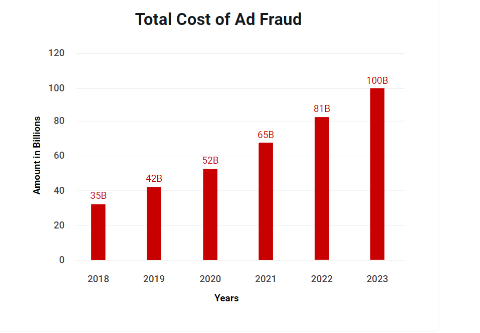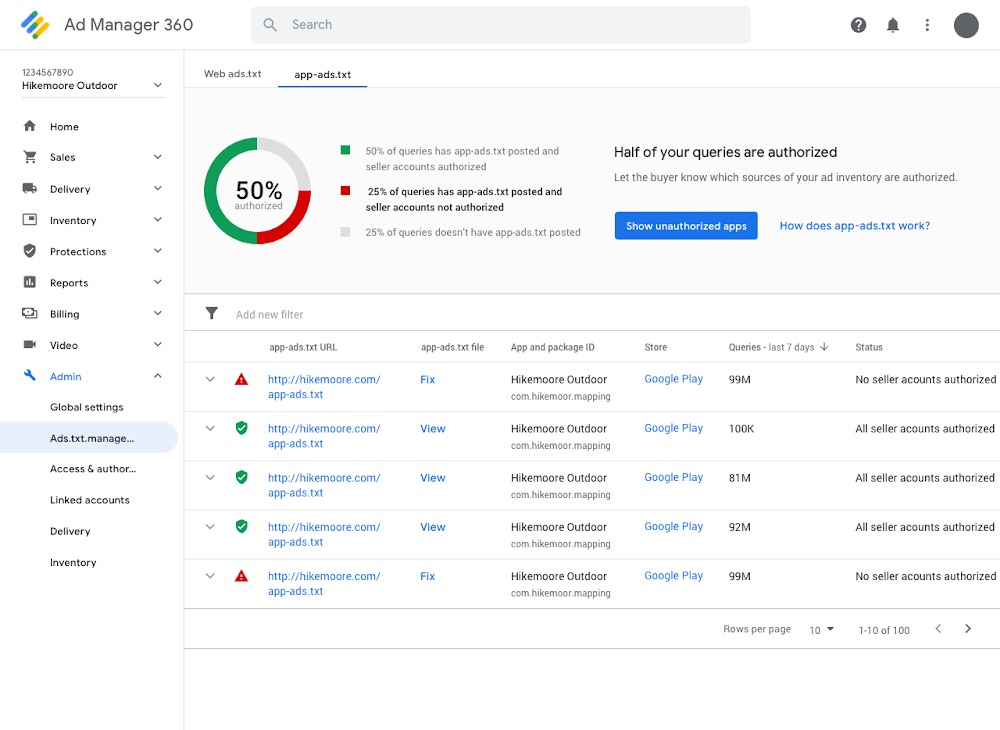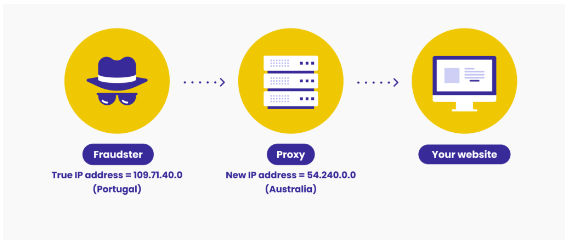7 min to read
To say that ad fraud is on the rise would be an understatement. This form of digital crime is more present now than ever. No matter how small or big your online advertising campaign is, or how far your brand has progressed, you are at high risk of ad fraud. That is unless you know how to combat it.
Fraudlogix’s cybercrime report found that ad fraud and bot-driven fraud made up almost 17% of ad impressions in Q2 2022. Ad fraud was the cause of businesses losing billions of dollars and suffering grand damages to their reputation.
According to Adobe’s report, 28% of the ad traffic in 2018 was fraudulent.
As a result, invalid traffic such as seen in ad fraud can cost an advertiser up to 30% of their budget. These days, such fraud is so present, that advertisers are starting to calculate this into their online advertising campaigns.
It’s a smart move if you have the extra budget considering that, in the US, advertisers lost $44 million in 2018 of advertising spend per day due to fake traffic.
CodeDesign is a leading digital marketing agency ranked #1 in Lisbon, Portugal. You could work with us to accelerate your business growth.

But, you’ll probably agree that a better option is to learn how to combat ad fraud in online advertising instead of sacrificing such a large sum of money for it.
That’s what this article is all about - to tell you more about ad fraud and give you tips that will help you with this.
Understanding ad fraud
Ad fraud is a method that dishonest marketers use to scam business owners out of their marketing budget. This is a serious problem, one that is hard to detect and even harder to deal with after it happens.
Most ad fraud is done with the help of malicious bot activity. Basically, bots imitate humans and do what brand owners want to see - more views on their posts, more visits to their sites, more subscriptions, checkouts, cart placements, etc.
The numbers look amazing, but these are all fake numbers. If you are a victim of ad fraud, you’ll see great numbers, but no real progress. There will be tons of new visits and followers, but no real engagement like you’d have with a real audience.
So, imagine this. You are paying a small fortune to a marketer trying to grow your profits, increase your audience, or widen your reach. After all, that’s what they are offering you. If the marketer uses bots to give you a sense of increased engagement, you’ll think that you made a good investment.
After a while, you’ll realize that this has done nothing real for you. Months and years will pass and you’ll have spent thousands on campaigns without a considerable increase in revenue or number of customers.
If this happens, you’ll suffer losses because you’ve been a victim of ad fraud.
The best ways to detect and/or combat ad fraud in advertising
Now that you know what this means and why you need to combat it, let’s get into action. Here are the top ways to beat ad fraud in online advertising:
1. Detect proxies with SEON’s API capabilities
Fraudsters often use proxies to hide their connection details. They do this to avoid being caught. However, you can easily detect proxies with SEON’s API and catch them in the act!
The answer to this is proxy detection. SEON, a top-rated fraud detection tool, offers proxy detection as one of its features. This is a process where you learn how people connect to your website. If done right, proxy detection can point to the bad agents who spoof connection details because they want to commit fraud.
Here is how fraudsters use proxies to commit ad and other forms of fraud:
Here is how this works. Let’s say that a fraudster is based in one country but wants to make it seem like your targeted audience visits your website from the location you’ve selected when creating the ad. They use proxies to make it look like the visits are from people from your targeted demographic.
In your eyes, this will look as if your ad campaign is working perfectly - attracting the people you’ve targeted with your ads. But, if you use SEON’s proxy and VPN detection, it will automatically find the red flags that tell you if you are dealing with a fraudster or not.
2. Know your ad fraud types
Sometimes you’ll be able to detect ad fraud just by looking at the numbers and stats. To do this, you need to know what constitutes ad fraud. This is why the next tip in our list is to learn the most common types of ad fraud and how to detect them.
So, let’s get through some of them:
- Cookie stuffing. Cookies are codes used to track the behavior of users and provide marketers with insight into their campaigns. Fraudsters insert cookies from other sites to change the payment model and attribution, or they place cookies on bots to make it seem like there are more impressions for a keyword than there are.
- Geo Masking. This is where the proxy tracking mentioned above comes in handy. In cases of geo masking or location fraud, scammers are sending false location data to make it seem as if they are from your targeted demographic.
- Click spamming/flooding. Usually targeting websites and apps, this variant of ad fraud works in the background. While it seems like the site or app works as it should, clicks happen in the background without the knowledge of the visitor.
- Click/ bot fraud. Click fraud is done on pay-per-click ads. In this case, the fraudsters trick the ad platform and make it believe that people are interacting with the content and their post is popular. Seeing this, companies spend more money to add more ads but aren’t getting any results.
- Domain spoofing. Domain spoofing occurs when fraudsters impersonate another domain, one with higher value and worth. While users and impressions are real, the website isn’t worthy of investment.
- Pixel stuffing. Fraudsters serve multiple pixels in a single frame, which makes the ads invisible to the user. So, they actually deliver the ads, but no one can see them, so the advertiser cannot possibly get something from their investment.
3. Target your audience more accurately
One of the mistakes marketers make in their ads is not investing enough time to research their audience and target the right people. This is actually a great method against fraudsters, too. The more precise you are about targeting your audience, the easier it will be for you to detect the red flags.
For example, if you have customers in a specific country in Europe and want to target only them, you’ll easily notice fraud if you get many views and visits from, let’s say, Asia.
4. Use Ads.txt
Ads.txt does more than just improve transparency for your brand. Recently, Google adopted ads.txt on over half of the ad space available on DoubleClick Bid Manager. This goes to show that ads.txt can help minimize ad fraud, and you can definitely use it for that purpose, too.

The IAB’s ads.txt protocol can help you avoid domain spoofing. While this is not a mandatory procedure, it is highly recommended.
5. Know Your Metrics
One of the best ways to improve your ads is to analyze their progress. Knowing the metrics is not just useful for this, but it can also help you identify ad fraud. By knowing the bounce rates, conversion rates, and session times for your advertisement campaign, you’ll easily detect many of the anomalies.
When you have the metrics, you can compare them to see if you’re a victim of ad fraud. For example, if you have a tremendous increase in PPC volume but a flat call volume, this is a clear red flag.
If you know what your ‘normal’ traffic is, you can notice abnormal, sudden traffic spikes almost immediately, as well as detect visits from unusual geographic locations.
6. Use trusted platforms
There’s a reason why Google, Bing, and social channels like Facebook are used by most marketers - they are safe. It’s not just because many people use them. These established companies go to great measures to protect their customers.
If you want to minimize the risk of ad fraud, avoid ad networks that aren’t high-rated and trusted among marketers. Focus primarily on big advertising networks like AdWords and Facebook. If you do want to use other networks, take caution.

Have you been taking any of these measures?
If you haven’t been doing at least half of this, your marketing campaign is far from safe. Save yourself tons of money and make sure that your reputation is good by going through this list and implementing all the tips in it.
AGENCY TRANSPARENCY
At Codedesign, as white hat digital marketing agency we believe that transparency is the way to fair competition.
Advertisers currently have concerns about agency transparency—or the lack thereof—in three primary areas: media rebates, programmatic fees, and data and tech sharing/ownership.
Media rebates (rappel) - Agencies often don’t disclose or pass along their rebates to their clients (also known as agency volume bonuses, or AVBs) they receive from media companies.
Programmatic fees - Programmatic digital-media buys often carry difficult-to-understand and at times opaque agency fees whose face value is small—pennies per activation—but can add up when the numbers involved reach into the millions.
Data and tech sharing/ownership - Agencies often to not give their advertisers full access and ownership to the data and tech assets generated by their marketing activities
Anti fraud policy - Agencies often to not give a clear policy on anti fraud.

About Bruno GavinoBruno Gavino is the CEO and partner of Codedesign, a digital marketing agency with a strong international presence. Based in Lisbon, Portugal, with offices in Boston, Singapore, and Manchester (UK) Codedesign has been recognized as one of the top interactive agencies and eCommerce agencies. Awarded Top B2B Company in Europe and Top B2C company in retail, Codedesign aims to foster personal relationships with clients and create a positive work environment for its team. He emphasizes the need for digital agencies to focus on data optimization and performance to meet the increasingly results-driven demands of clients. His experience in digital marketing, combined with a unique background that includes engineering and data, contributes to his effective and multifaceted leadership style. |

About CodedesignCodedesign is a digital marketing agency with a strong multicultural and international presence, offering expert services in digital marketing. Our digital agency in Lisbon, Boston, and Manchester enables us to provide market-ready strategies that suit a wide range of clients across the globe (both B2B and B2C). We specialize in creating impactful online experiences, focusing on making your digital presence strong and efficient. Our approach is straightforward and effective, ensuring that every client receives a personalized service that truly meets their needs. Our digital agency is committed to using the latest data and technology to help your business stand out. Whether you're looking to increase your online visibility, connect better with your audience, get more leads, or grow your online sales. For more information, read our Digital Strategy Blog or to start your journey with us, please feel free to contact us. |
CodeDesign is leading:
- Digital Agency
- Digital Marketing Agency
- Digital Ecommerce Agency
- Amazon Marketing Agency
Feel free to contact us to see the unprecedented growth of your business.




Add comment ×